Mario Kart DS
Released: November 14, 2005
Mario Kart DS , abbreviated to MKDS or MK:DS , is a racing game developed and published by Nintendo for the Nintendo DS . It is the fifth installment in the series and the first to use Nintendo's free online service, Nintendo Wi-Fi Connection. Released in North America and Europe in November 2005, and in Japan in December 2005, it was well received critically, scoring an average of 91% from Metacritic.
Racing in Mario Kart DS involves various characters from various mario games racing each other in go-karts on tracks themed from locations in the Mario series. Less realistic physics, and the use of various weapons and or items to achieve victory differentiates kart racing games like MK:DS from racing simulators like Gran Turismo. Multiplayer for eight players is supported via wireless linkup, and online play for up to four players is supported via Nintendo's WiFi connection.
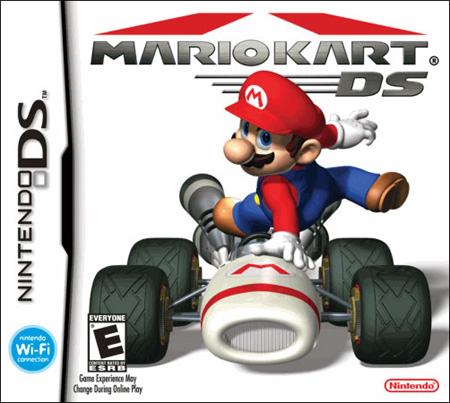
While racing, the top screen of the Nintendo DS displays a third-person perspective behind and slightly above the player's vehicle. The bottom screen lists the current race standings, items carried by each player, and a map of the course. The map can be toggled to show an overall view of the entire course, or a close-up view of the racer's immediate vicinity. The close-up view is very detailed, showing nearby racer positions, course hazards, item boxes, and even incoming attacks. As the close-up rotates in orientation to the racer, it is possible to complete an entire race focusing only on the bottom screen.
Mini-Turbos
A feature first introduced in Mario Kart 64, Mini-Turbos are momentary speed boosts that can be obtained while drifting.
Snaking
The execution of several consecutive mini-turbos during races has caused minor controversy in Wi-Fi play in the form of snaking -- players who drift their karts back and forth across a straight stretch to generate repeated mini-Turbos (a movement likened to actual snakes). Because this gives the user a distinct speed advantage over other, "non-snaking" opponents, players regard snaking as anything from legitimate and advanced racing strategy, to an unfair tactic, or even outright cheating. Some players have attempted to form leagues (or "Friends" groups) composed of avowed “non-snakers”, but the distinction between a "snaker" and "non-snaker" is vague, largely depending on whether the player uses Mini-Turbos on straight areas of the track or on curves.
Nintendo Power magazine once responded to a reader mail in its Pulse section, describing snaking as "kind of lame" and that it goes against the original intentions of the game's developers. Others have similarly argued that snaking is an exploitation of game's Mini-Turbo mechanics; on the other hand, some Nintendo officials have described snaking as an intentional part of the game's design, considering that the snaking technique could also be performed in Mario Kart 64 (which featured similar Mini-Turbo mechanics). All of the Time Trial records in Mario Kart DS were accomplished using this technique.
Drafting
Featured in Mario Kart DS is the ability to draft behind an opponent's kart. If the player is close enough, blue streaks will start flying by their kart, and their speed will begin to increase. If the player maintains this position (without hitting the opponent, an obstacle, or otherwise losing speed) long enough, they will receive a noticeable speed boost, allowing them to easily overtake and pass the opponent. This was also possible in Mario Kart 64. They will also be able, while the effect lasts, to bump other karts out of the way, even if they are lighter than the other kart.
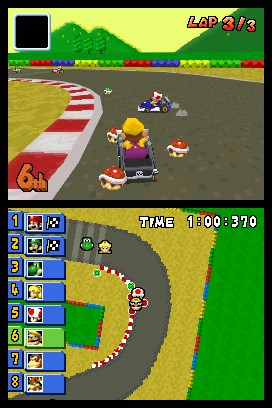
Emblems
New to this game are 'emblems', or player icons. Using a simple drawing program interface, a player can select from (and modify) a variety of pre-made shapes, or create a customized emblem from scratch. During the race, each player's emblem appears as a decal on their kart, and in multi-player matches, opponents can see the player's name and emblem prominently overlaid above their kart's position on the opponent's screen (as a way to identify and discern one opponent from another). The player's emblem is also, on Wi-Fi play, shown to their opponents once the Nintendo Wi-Fi Connection has found opponents and initiated a match.
Characters
There are 13 characters in this game, 8 of them are old, 2 of them have returned from Mario Kart: Double Dash!!, and 3 of them are new to the series.
- Mario
- Luigi
- Princess Peach
- Princess Daisy
- Yoshi
- Toad
- Donkey Kong
- Wario
- Waluigi
- Bowser
- Shy Guy (DS Download Play Only) (new)
- Dry Bones (new)
- R.O.B. (new)
Note: Princess Daisy, Waluigi, Dry Bones and R.O.B. have to be unlocked.
Items
As in previous Mario Kart games, each course features numerous item boxes that players can drive through to receive a randomly-selected item. Whichever item the player receives is generally dependent upon their current position in the race (and, to a lesser extent, their kart's Items stat); players near the front will tend to receive rear-attack items (such as Bananas or Green Shells), while players trailing in the back of the race will tend to receive more powerful and forward-attack items like the Spiny Shell or Thunderbolt. As in previous Mario Kart games, most but not all attack items (e.g., spiny shells) can be targeted forwards or backwards by holding the appropriate direction on the D-pad when using the item against other players.
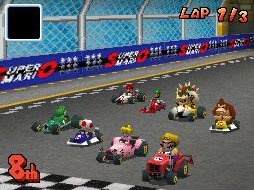
Karts
Each playable character starts out with two karts: one special kart unique to that character, and a standard kart resembling a real go-kart . These karts have slightly different stats, although their general strengths are the same. As a player progresses through the game, he or she can unlock a third special kart for each character, also with slightly different stats. Later, the player can also unlock the ability to choose a few karts not normally available to the particular character, and ultimately, the ability to use any of the 36 total karts with that character.
When a player is selecting their kart for a race, the game openly lists the kart's Max speed, acceleration, weight, handling, drifting ability, and the Quality of items the kart is likely to receive.
Tracks
There are eight cups in the game, 4 tracks each. The first 4 cups contain new tracks listed in the Nitro Grand Prix and the other 4 are taken from all the other Mario Kart games listed in the Retro Grand Prix. A total of 32 tracks to race on.
Nitro Grand Prix Tracks
Mushroom Cup |
Flower Cup |
Star Cup |
Special Cup |
| Figure-8 Circuit | Desert Hills | DK Pass | Wario Stadium |
| Yoshi Falls | Delfino Square | Tick-Tock Clock | Peach Gardens |
| Cheep-Cheep Beach | Waluigi Pinball | Mario Circuit | Bowser's Castle |
| Luigi's Mansion | Shroom Ridge | Airship Fortress | Rainbow Road |
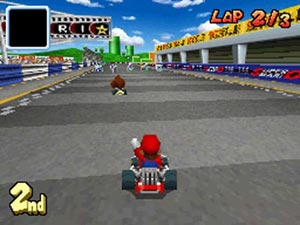
Retro Grand Prix Tracks
Shell Cup |
Banana Cup |
Leaf Cup |
Lightning Cup |
| SNES Mario Circuit 1 | SNES Donut Plains 1 | SNES Koopa Beach 2 | SNES Choco Island 2 |
| N64 Moo Moo Farm | N64 Frappe Snowland | N64 Choco Mountain | N64 Banshee Boardwalk |
| GBA Peach Circuit | GBA Bowser Castle 2 | GBA Luigi Circuit | GBA Sky Garden |
| NGC Luigi Circuit | NGC Baby Park | NGC Mushroom Bridge | NGC Yoshi Circuit |
Gameplay modes
Grand Prix
In Grand Prix mode, the player competes against seven computer-controlled racers. There are two Grand Prix in Mario Kart DS , each consisting of four cups, and each cup consisting of four race tracks. Nitro GP (named after Nintendo Codename NITRO) contains sixteen brand new tracks while Retro GP contains sixteen tracks converted from previous entries in the Mario Kart series. There are three engine classes which serve as difficulty levels for the Grand Prix mode: 50cc, 100cc, and 150cc. The higher the engine class, the faster all the karts go. This serves as the difficulty level, because it is often harder to drift and turn. A 150cc Mirror Mode is also an unlockable, in which all the 150cc tracks are flipped horizontally, as if seeing the game in a mirror.
Only twenty of the tracks can be played over Nintendo Wi-Fi connection. Several of the more complex and/or obstacle-ridden courses (such as Bowser's Castle) were disabled from online play due to concerns over potential bugs caused by latency.
Battle Mode
Battle Mode is not available online, and can only be played in single-player and regular multiplayer.
These courses are built like an arena, generally in a symmetric circular or square form with each player starting out at a different location, and item boxes scattered throughout the course for players to pick up. Some of the arenas are on flat terrain and surrounded by walls, while others are surrounded by empty space in which a player might fall off. Either you play Balloon Battle, where you try to pop everyone else's balloons by attacking them or steal them with mushrooms and eliminate them, or Shine Runners, where you try to collect the most shine sprites and players with least amount get eliminated over time.
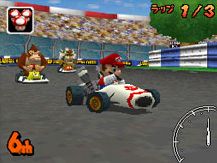
Multiplayer
The game features 8-player single-card and multi-card LAN play. Single-card play can be played with a mix of players with and without cards. However, players who do not have a copy of the game must play as Shy Guy (who is not otherwise available) and are not allowed to select their character or kart.
Mission Mode
In the new Mission Mode, players control a specific character in that character's standard kart, and must perform eight individual missions, whose objectives range from collecting coins to attacking enemies. Players are then ranked based on their performance, and given from one to three stars if the task is completed by a certain time. In order to advance to the next level, players must complete a "boss" task, which is unlocked after all eight of a level's missions are completed. Level 7 is only unlocked after the player achieves at least a one-star ranking on levels 1 through 6. Completing all missions in level 1 through 6 with at least a 1 star rating on each mission opens up a secret 7th level with more challenging missions to complete. It should be noted that there are no missions where one of the unlockable characters is playable.
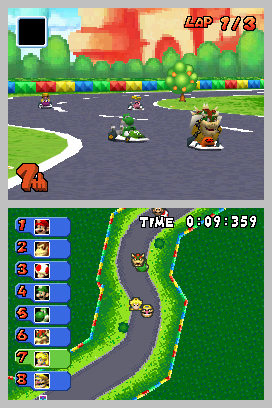
Time Trials
In this mode, the player is able to race against the clock; the results of a Time Trial run are saved as "Ghost Data", which the player can compete against later (for a faster time), or traded with friends. Also, it is possible to unlock Mario Kart DS "Staff Ghost Data" by completing a circuit within a certain amount of time.
Nintendo of Japan has recently revealed that they will begin holding official time trial tournaments. Times will be validated by an official 16 digit code. The code can be found by viewing the time trials records accessed from the main menu and pressing up, down, L, R, Y, and A in that order. Whether or not Nintendo of America and Nintendo of Europe will hold similar tournaments has not been announced.

